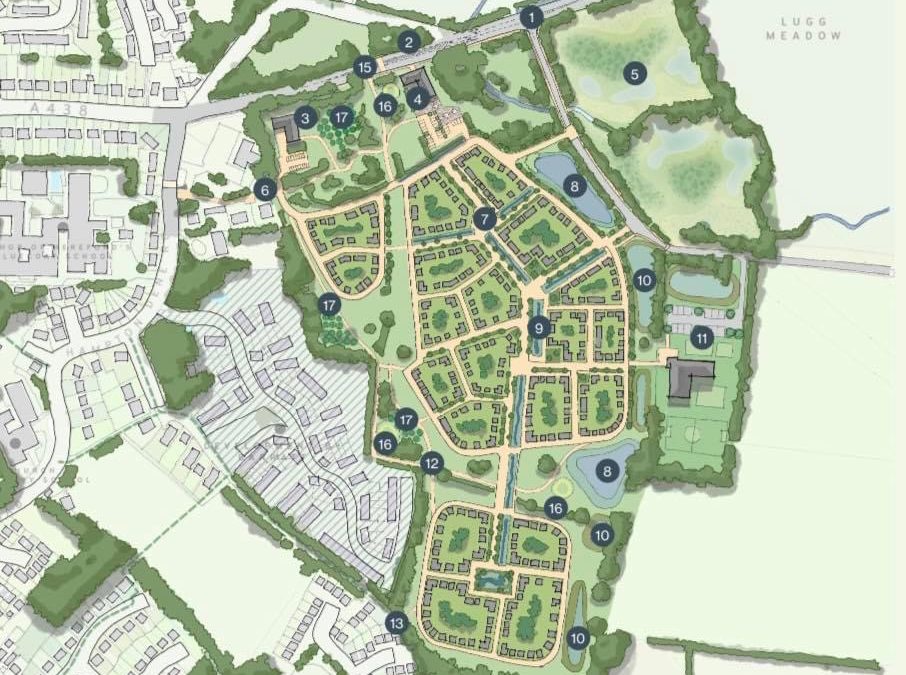Herefordshire Wildlife Trust is submitting an objection to the planning application for the development of land East of Hereford (Planning reference P240422/F) which borders the Lugg Meadows Nature Reserve, a Site of Special Scientific Interest (SSSI) and ecologically important floodplain meadow.
The application details the erection of up to 350 dwellings, a farm shop and café, employment workspaces, and land for a potential primary school, along with associated parking and access roads.
The Trust’s primary concern is that there would be a greatly increased number of people visiting the Lugg Meadows, an increased number of dogs and cats, noise, light pollution and traffic.
This is likely to have a significant impact on the flora and fauna of the meadows. In particular, the increased disturbance would impact the breeding curlew, which are already threatened with local extinction and the subject of a conservation project at the site.
SSSI status is the greatest protection a habitat can have in the UK and should mean it is preserved in perpetuity. Floodplain meadows have become incredibly rare with only around 1,200 hectares of this habitat remaining in the UK.
They fulfil natural functions of flood management, pollution reduction and carbon sequestration alongside the provision of fantastic, specialised, wildlife habitat.
This habitat is also included in Herefordshire’s Biodiversity Action Plan as one that conservation groups have identified as particularly under threat in the county and in need of preservation. The nature reserve is home to many rare species of plants and animal including the snake’s head fritillary and a small population of breeding curlew.
Herefordshire Wildlife Trust are currently running a project to recover rare floodplain plants on Lugg Meadows. Funded by Natural England (NE) through its flagship Species Recovery Programme (SRP), the project aims to recover populations of narrow-leaved water-dropwort and mousetail – through habitat enhancement and sowing and planting at the meadows which lie within the River Wye Catchment.
The Trust also has concerns about the impact on the River Lugg, designated a Special Area of Conservation, already under huge pressure from pollution and described by Natural England as “unfavourable/declining.”
The proposals do not guarantee that run-off from the development (which may include a wide range of pollutants e.g. oils, phosphates from car washings, paints, bleach) cannot enter the Lugg Rhea and, from there, the meadows and the River Lugg.
Much of Lugg Meadows is owned by Herefordshire Wildlife Trust with some areas also owned by the charity Plantlife.
Sarah King, Nature Recovery Manager at Herefordshire Wildlife Trust says:
“Lugg Meadows Nature Reserve are an absolute jewel of Herefordshire’s natural history. It is nationally significant for its rare species such as the beautiful snake’s-head fritillary and one of very few traditionally managed, ecologically rich floodplain meadows in the UK. It is designated as a Site of Special Scientific Interest, the highest protection a site can have and it is imperative that it is protected as it should be.
“To have such a site so close to the City is a real treat for residents and visitors. However, being close to urban areas brings a lot of pressure from high numbers of visitors and dog walkers.
“To date, we have just about managed to balance the visitor access with conservation of wildlife but having a major new residential area right alongside the site will be devastating for the sensitive plants, birds and animals that call the nature reserve home.”
Jenny Hawley, Plantlife Policy Manager, said:
“Plantlife is deeply concerned about development proposals on land east of Hereford due to the high risk of unacceptable impacts on Lugg Meadow Nature Reserve next to the site.
“This Plantlife nature reserve is a legally-protected Site of Special Scientific Interest, with a fragile ecosystem and nationally-scarce plant species including Narrow-leaved Water-dropwort (Oenanthe silaifolia). It is also one of the few ancient Lammas floodplain meadows remaining in England, adjacent to the River Lugg and part of the wider River Wye catchment.
“The proposed 350-home development would risk irreversible damage to this precious, sensitive ecosystem through increased water pollution, noise and light pollution, road traffic and footfall from visitors.”




